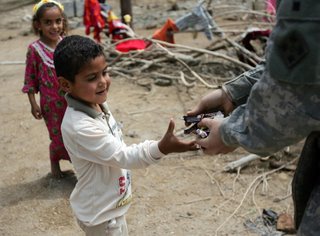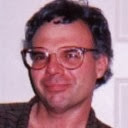The torture deaths and bodily desecrations of 2 US soldiers, Kristian Menchaca and Thomas Tucker in Jurf as Sakhr, Iraq (not Yusufiyah, as frequently claimed in the media), have been all over the news since their bodies were discovered late Monday, June 19. The type of torture that was inflicted on them or their bodies is the subject of much speculation.
The US military has revealed very little in the way of details. However, leaked details of the nature of the tortures inflicted on the men have been revealed and are propagating across the blogosphere. A comprehensive summary of the exact nature of the men's tortures, complete with sources, can be found on this blog here.
One thing that no one has yet discussed anywhere is where the men or their bodies were taken to be tortured. Note that recent US military statements cast doubt on whether the men were killed in action and later had their bodies desecrated or where captured alive and tortured to death.
First, let us note the location of the initial attack that led to this debacle. The attack occurred at a checkpoint on a bridge where a canal meets the Euphrates River on the outskirts of a town called Karagol, near Jurf as Sakhr, which is in the Triangle of Death south of Baghdad (excellent, detailed map of the Triangle of Death on this blog here).
US soldiers found the bodies on the evening of June 19, lying in a ditch by the side of the road near a power plant in Jurf As Sakhr.
Reports from Dallas Morning News journalists embedded with the military talk about a large base, Forward Operating Base Iskan, or Forward Operating Base Iskandariyah, in or near Jurf as Sakhr, and mention a prominent power plant in the middle of town.
This lines up with reports about the bodies being found near a power plant in Jurf as Sakhr and reports that the soldiers were part of a contingent from a nearby large US base. FOB Iskandariyah is right next to a huge power plant.
The power plant in Jurf as Sakhr is in the center of town and dominates it. The aging plant, built in the 1970's with Soviet technology, pours black smoke constantly and spills crude oil all over the area around it via oil bubbling to the surface, often a ways away from the plant. The police station in Jurf as Sakhr was first blown up by guerrillas last year. The police station was rebuilt this year, and guerrillas blew it up again. It is now being rebuilt for the second time.
 A roadside bomb explodes near US military patrol in Jurf as Sakhr in April. Fortunately, the bomb was not close enough to the patrol to cause any damage. The Jurf as Sakhr area is totally hostile.
A roadside bomb explodes near US military patrol in Jurf as Sakhr in April. Fortunately, the bomb was not close enough to the patrol to cause any damage. The Jurf as Sakhr area is totally hostile.US troops withdrew from Jurf as Sakhr on Tuesday, June 20, and as they withdrew, they set fire to warehouses next to the power plant where the bodies were discovered. Residents later put out the fires. Reports of the behavior of US troops during the search do not report extensive property destruction in the area, nor do they report random beatings and shootings of civilians.
Therefore, the fact that the troops set those warehouses on fire just before they left is peculiar. No doubt these warehouses were searched around the time the soldiers were found dead.
If evidence of the men's torture deaths or bodily desecrations (blood on the floors or walls, etc.) was found, isn't it possible that the troops may have reacted to this by setting the warehouse-torture centers on fire just before they vacated the town? I can't think of any other reason to set the warehouses on fire. Consider that:
- There was little random property destruction by US forces in the area
- The warehouses were right next to the where the men's bodies were found
- The mutilated bodies were probably not moved very far from where they were tortured, killed and eviscerated
- As a last act before vacating the city, US forces inexplicably set fire to the warehouses
Update: We now have a second witness report from Iraqis who witnessed the attack on the 3 US troops in their Humvee on Friday, June 16 - the attack that set off the ensuing nightmare. This gives us three alternative scenarios regarding the capture of the troops:
- An Iraqi initially reported that there were three Humvees at a checkpoint near a fruit grove. Guerrillas attacked the checkpoint from the fruit grove and two of the Humvees took off into the grove after the guerrillas. The guerrillas retreated into the grove, apparently to draw the two Humvees away and isolate the third Humvee.
Seven guerrillas clad in black athletic suits and masks then swarmed the third Humvee. Two guerrillas were armed with RPG's and one was armed with a heavy machine gun. In the course of swarming the vehicle, Spc. David J. Babineau was killed and Menchaca and Tucker were wounded. The guerrillas then led Menchaca and Tucker off to two waiting vehicles and sped away. One vehicle was later found abandoned with bloodstains on the back seat. - US forces dispute this account, saying only that the three soldiers were manning a checkpoint with the rest of their patrol when the other vehicles in the patrol left to go check traffic, leaving the lone Humvee at the checkpoint.
- We now have a third account. On Wednesday, June 21, Reuters quoted Omar Abdullah as saying that there was a US patrol in the area with numerous vehicles in it. A lone Humvee fell behind the rest of the patrol by about 300 yards. At that point, it was swarmed by about 30 guerrillas in Land Cruisers and Toyotas. The attack stirred up a lot of dust, so the rest of the patrol could not see what was going on. The driver was quickly killed. After a bit, Menchaca and Tucker were overwhelmed and taken prisoner.
Note: Readers should carefully read the Commenting Rules before commenting to avoid having their comments edited or deleted and to avoid being banned from the site.



No comments:
Post a Comment